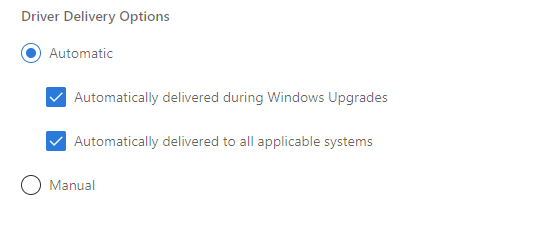Note
Access to this page requires authorization. You can try signing in or changing directories.
Access to this page requires authorization. You can try changing directories.
This article describes how you can control when Windows Update distributes your driver.
When you submit a driver to Windows Update, the Driver Delivery Options section presents two radio buttons: Automatic and Manual
Under the Automatic option there are two checkboxes: Automatically delivered during Windows Upgrades and Automatically delivered to all applicable systems. Automatic is the default setting for all new shipping labels.

When the first checkbox is selected, the driver is classified as a Dynamic Update (a term that applies to upgrade scenarios). Windows automatically preloads drivers in this category when upgrading the OS.
When the second checkbox is selected, the driver is downloaded and installed automatically on all applicable systems, once released. All Automatic drivers must first be evaluated by Microsoft through Driver Flighting.
For more info about the Manual option, see Publish a driver to Windows Update.
User plugs in a device
When a device is connected to a Windows system:
Plug and Play (PnP) looks for a compatible driver already available on the computer.
If one exists, Windows installs it on the device. Then, during the next daily scan of Windows Update, Windows searches for a more up-to-date version of the driver. This process can take up to 24 hours from when the device is plugged in.
If there's no compatible driver on the computer, Windows searches Windows Update immediately for the highest-ranking Automatic driver.
When searching Windows Update:
In Windows 10, version 1909 and earlier, if no Automatic driver is available for the device, Windows proceeds to the highest-ranking Manual driver.
Starting in Windows 10, version 2004, Windows doesn't search for a Manual driver when an Automatic driver isn't available. For info on how to access Manual drivers, see the Windows Update section of this page.
Device Manager
In Device Manager, when a user selects Update driver:
- In Windows 10, version 1909 and earlier, Windows installs the highest-ranking driver from Windows Update, regardless of whether the driver is classified as Automatic or Manual.
- Starting in Windows 10 version 2004, Windows only searches the local computer.
When it fails to find a driver, Device Manager shows a button labeled Search for updated drivers on Windows Update, which opens the Settings app to the Windows Update page. To find this button, right-click a device and select Properties. On the Driver tab, select Update Driver and then Search automatically for drivers.
- Starting in Windows 10, version 2004, select Search for updated drivers on Windows Update and then select View optional updates->Driver updates to download Manual drivers.
- In earlier versions of Windows, Device Manager downloads Manual drivers on its own.
Windows Update
During a Windows Update scan (scheduled or user-initiated):
In Windows 10, version 1909 and earlier, Windows Update automatically distributes Manual drivers in either of the following scenarios:
- A device has no applicable drivers available in the Driver Store (raising a "driver not found" error), and there's no applicable Automatic driver
- A device has only a generic driver in the Driver Store, which provides only basic device functionality, and there's no applicable Automatic driver
Starting in Windows 10, version 2004, Windows Update distributes only Automatic drivers for a system's devices. When Manual drivers are available for devices on the computer, the Windows Update page in the Settings app displays View optional updates .
Summary
The following table is a summary of the information in this article.
| Driver delivery options | OS upgrades | Connecting new device | Device Manager | Windows Update (WU) scan | WU Optional updates page |
|---|---|---|---|---|---|
| Automatic (both checkboxes) | Yes | Only if the local driver is generic or missing | Only in Windows 10, version 1909 and earlier | Yes | No |
| Automatic (to all applicable systems) | Yes | Only if the local driver is generic or missing | Only in Windows 10, version 1909 and earlier | Yes | No |
| Automatic (during Windows Upgrades) | Yes | No | Only in Windows 10, version 1909 and earlier | No | Yes |
| Manual in Windows 10, version 1909 and earlier | No | Only if the local driver is generic or missing, and WU has no applicable Automatic driver | Yes | Only if the local driver is generic or missing, and WU has no applicable Automatic driver | N/A |
| Manual in Windows 10, version 2004 and later | No | No | No | No | Yes |